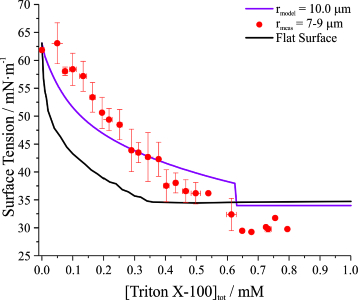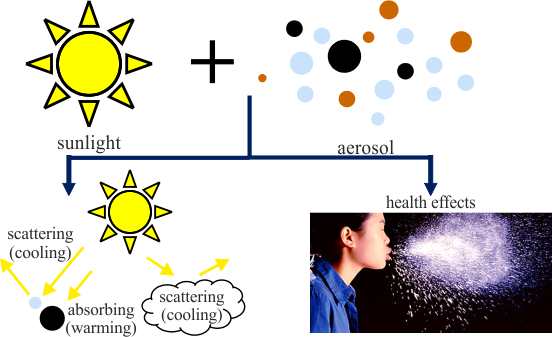Research Projects
We tackle grand challenges in domains including atmospheric science, human health, and materials science where aerosols play a key role. Much of our work involves developing unique instrumentation to address these challenges in novel ways.
Surface Tension of Aerosols and Microscopic Droplets
This project examines the interfacial composition of picolitre volume droplets. Aerosols have high surface to volume ratios, highlighting the significance of the aerosol surface. We develop unique approaches to measure directly the dynamic and equilibrium properties of microscopic droplet interfaces. Because surfactant partitioning in finite volume systems is complex, we are focussed on how surfactants partition to the droplet-air interface. The results will help constrain the appropriate value for surface tension for incorporation in climate models as well as advance our ability to predict the surface composition of microscopic systems.


“Surfactant Partitioning Dynamics in Freshly Generated Aerosol Droplets,” A. Bain, L. Lalemi, N. Croll Dawes, R. E. H. Miles, A. M. Prophet, K. R. Wilson, and B. R. Bzdek, Journal of the American Chemical Society, 2024, 146, 16028–16038
“Surface-Area-to-Volume Ratio Determines Surface Tensions in Microscopic, Surfactant-Containing Droplets,” A. Bain, K. Ghosh, N. L. Prisle, and B. R. Bzdek, ACS Central Science, 2023, 9, 2076–2083
“The Surface Tension of Surfactant-containing, Finite Volume Droplets,” B. R. Bzdek, J. P. Reid, J. Malila, and N. L. Prisle, Proceedings of the National Academy of Sciences of the United States of America, 2020, 117, 8335-8343
Respiratory Aerosol Generation and Dynamics
This project quantifies aerosol and droplet generation from activities including breathing, speaking, performing arts, exercise, and medical procedures. The results inform public policy decisions guiding our response to the COVID-19 pandemic.

“The Filtration Efficiency of Surgical Masks for Expiratory Aerosol and Droplets Generated by Vocal Exercises,” A. Szczepanska, J. Harrison, B. Saccente-Kennedy, J. Archer, N. A. Watson, C. M. Orton, W. J. Browne, R. Epstein, J. D. Calder, P. L. Shah, D. Costello, B. R. Bzdek, and J. P. Reid, Aerosol Science and Technology, 2023, 58, 39-53
“Emission Rates, Size Distributions, and Generation Mechanism of Oral Respiratory Droplets,” J. Harrison, B. Saccente-Kennedy, C. M. Orton, L. P. McCarthy, J. Archer, H. E. Symons, A. Szczepanska, N. A. Watson, W. J. Browne, B. Moseley, K. E. J. Philip, J. H. Hull, J. D. Calder, D. Costello, P. L. Shah, R. Epstein, J. P. Reid, and B. R. Bzdek, Aerosol Science and Technology, 2023, 57, 50-62
“Aerosol and Droplet Generation from Performing with Woodwind and Brass Instruments,” L. P. McCarthy, C. M. Orton, N. A. Watson, F. K. A. Gregson, A. E. Haddrell, W. J. Browne, J. D. Calder, D. Costello, J. P. Reid, P. L. Shah, and B. R. Bzdek, Aerosol Science and Technology, 2021, 55, 1277-1287
“Aerosol Generating Procedures: Are They of Relevance for Transmission of SARS-CoV-2?,” F. Hamilton, D. Arnold, B. R. Bzdek, J. Dodd, AERATOR Group, J. Reid, N. Maskell, The Lancet Respiratory Medicine, 2021, 9 , 687-689
“Accurate Representations of the Microphysical Processes Occurring during the Transport of Exhaled Aerosols and Droplets,” J. S. Walker, J. Archer, F. K. A. Gregson, S. E. S. Michel, B. R. Bzdek, and J. P. Reid, ACS Central Science, 2021, 7, 200-209
Mass Spectrometry of Aerosols
We are pioneering new experimental approaches for the chemical characterisation of aerosols and droplets by mass spectrometry. These novel tools will have wide utility across all application areas in aerosol science.

“Rapid and Sensitive Chemical Analysis of Individual Picolitre Droplets by Mass Spectrometry,” J. S. Walker and B. R. Bzdek, Analytical Chemistry, 2025, 97, 854-861
“The Role of Aerosol Liquid Water in Droplet-Assisted Ionization Mass Spectrometry,” J. Harrison, K. M. Risby, B. E. A. Miles, T. G. Hilditch, J. S. Walker, and B. R. Bzdek, Analytical Chemistry, 2025, 97, 19918-19925
Photoinitiated Chemistry in Aerosols
We are working to resolve the factors that govern photoinitiated processes in aerosols. Although light and atmospheric aerosols are ubiquitous, the chemistry driven by their interaction is poorly understood.
